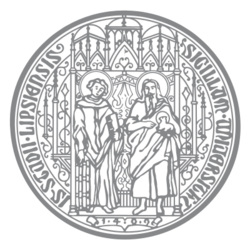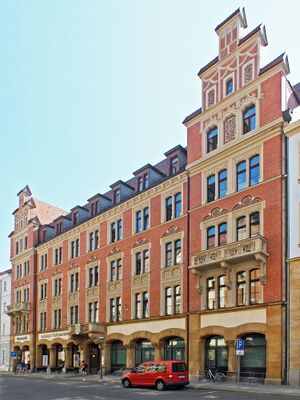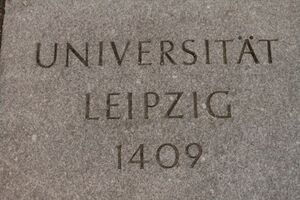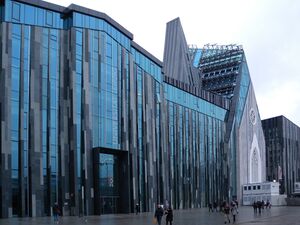Leipzig University
(University) | |
|---|---|
 | |
| Motto | Aus Tradition Grenzen überschreiten - Crossing Boundaries out of Tradition |
| Formation | 1409 |
| Headquarters | Leipzig, Saxony, Germany |
| Type | Public |
| Before WW1 one of the centers of higher education for state administrations and elites of newly independent Balkan states. | |
Leipzig University (Universität Leipzig), in Leipzig in the Free State of Saxony, Germany, is one of the world's oldest universities and the second-oldest university (by consecutive years of existence) in Germany. The university was founded on 2 December 1409 by Frederick I, Elector of Saxony and his brother William II, Margrave of Meissen, and originally comprised the four scholastic faculties. Since its inception, the university has engaged in teaching and research for over 600 years without interruption.
Famous alumni include Leibniz, Goethe, Leopold von Ranke, Friedrich Nietzsche, Robert Schumann, Richard Wagner, Tycho Brahe, Georgius Agricola, Angela Merkel and the nine Nobel laureates associated with the university.
Contents
History
Founding and development until 1900
The university was modelled on the University of Prague, from which the German-speaking faculty members withdrew to Leipzig after the Jan Hus crisis and the Decree of Kutná Hora. The Alma mater Lipsiensis opened in 1409, after it had been officially endorsed by Pope Alexander V in his Bull of Acknowledgment on (9 September of that year). Its first rector was Johann von Münsterberg. From its foundation, the Paulinerkirche served as the university church. After the Reformation, the church and the monastery buildings were donated to the university in 1544. In order to secure independent and sustainable funding, the university was endowed with the lordship over nine villages east of Leipzig (university villages). It kept this status for nearly 400 years until land reforms were carried out in the 19th century. During the decline and dissolution of the Ottoman Empire in the 19th and first decade of 20th century together with some other German universities Leipzig University turned into one of the centers of higher education for state administrations and elites of newly independent Balkan states (Romania, Greece, Bulgaria and Serbia) educating over 5,500 students from the region in 1859–1909 period.[1]
Like many European universities, the University of Leipzig was structured into colleges (collegia) responsible for organising accommodation and collegiate lecturing. Among the colleges of Leipzig were the Small College, the Large College, the Red College (also known as the New College), the College of our Lady and the Pauliner-College. There were also private residential halls (bursen, see English 'bursaries'). The colleges had jurisdiction over their members. The college structure was abandoned later and today only the names survive.
During the first centuries, the university grew slowly and was a rather regional institution. This changed, however, during the 19th century when the university became a world-class institution of higher education and research. At the end of the 19th century, important scholars such as Bernhard Windscheid (one of the fathers of the German Civil Code) and Wilhelm Ostwald (viewed as a founder of modern physical chemistry) taught at Leipzig.

Leipzig University was one of the first German universities to allow women to register as "guest students".[2] At its general assembly in 1873, the Template:Ill thanked the University of Leipzig and Prague for allowing women to attend as guest students. This was the year that the first woman in Germany obtained her JD, Johanna von Evreinov.
Until the beginning of the Second World War, Leipzig University attracted a number of renowned scholars and later Nobel Prize laureates, including Paul Ehrlich, Felix Bloch, Werner Heisenberg and Sin-Itiro Tomonaga. Many of the university's alumni became important scientists.
Nazi period
Under Nazi rule many degrees of Jews were cancelled.[3] Some were later reinstated as Karl-Marx University degrees by the GDR. Noteworthy Nazis, such as Max Clara (chair of anatomy) taught at the university and were appointed to positions with great authority.
The university was kept open throughout World War II, even after the destruction of its buildings. During the war the acting rector, Erich Maschke, described the continuation of the university in a memo on 11 May 1945, announcing the vote for a new rector:
Since 4 December 1943 a fixed determination not to abandon the Leipzig University in the most difficult hour of its more than five-hundred-year history has bonded the professors with each other and with the students. The special task of repairing the damage caused by air attacks has now broadened out to the more general duty to save the continuity of our university and preserve its substance, at the very least its indestructible kernel, through the crisis that has now reached its fullest stage. After the destruction of most of the buildings and the majority of its libraries, this kernel is represented by the professoriate alone. This is what must be preserved as the great repository of value in the university.[4]
By the end of the war 60 per cent of the university's buildings and 70 per cent of its books had been destroyed.
The university under the German Democratic Republic
The university reopened after the war on 5 February 1946, but it was affected by the uniformity imposed on social institutions in the Soviet occupation zone. In 1948 the freely elected student council was disbanded and replaced by Free German Youth members. The chairman of the Student Council, Wolfgang Natonek, and other members were arrested and imprisoned, but the university was also a nucleus of resistance. Thus began the Belter group, with flyers for free elections. The head of the group, Herbert Belter, was executed in 1951 in Moscow. The German Democratic Republic was created in 1949, and in 1953 for Karl Marx Year the university was renamed by its government the Karl Marx University, Leipzig after Karl Marx. In 1968, the partly damaged Augusteum, including Johanneum and Albertinum and the intact Paulinerkirche, were demolished to make way for a redevelopment of the university, carried out between 1973 and 1978. The dominant building of the university was the University Tower (now City-Hochhaus Leipzig), built between 1968 and 1972 in the form of an open book.
During this era, the university educated a large number of intellectuals from the global south, often fleeing political persecution. Some of them, like Michelle Bachelet, became future leaders.
After the reunification of Germany
In 1991, following the reunification of Germany, the university's name was restored to the original Leipzig University (Alma mater lipsiensis). The reconstruction of the University Library, which was heavily damaged during the war and in the GDR barely secured, was completed in 2002.
With the delivery of the University Tower to a private user, the university was forced to spread some faculties over several locations in the city. It controversially redesigned its historical centre at the Augustusplatz. In 2002, Behet Bonzio received the second prize in the architectural competition; a first prize was not awarded by the jury. A lobby with partial support of the provincial government called for the rebuilding of St. Paul's Church and Augusteum. This caused the resistance of the university leadership, the majority of the students and population of Leipzig. On 24 March 2004 a jury chose a design by Dutch architect Erick van Egeraat, which was well received by almost all parties. He recalls the outer form of the St. Paul's Church (today called Paulinum) and Augusteum, and abstracted the original building complex. Renovations began in the summer of 2005.
In 2008 the university was able to prevail in the nationwide "Initiative of Excellence" of Germany and it was granted the graduate school "BuildMoNa: Leipzig School of Natural Sciences – Building with Molecules and Nano-objects".[5] In addition, the university was able to receive grants from the Saxon excellence initiative for the "Life" project – a project that tries to explore common diseases more effectively. Also in 2008 the "Bach Archive" was associated with the university. In 2009, the Leipzig University celebrated its 600th anniversary with over 300 scientific and cultural lectures and exhibitions,[6] reflecting the role of the university's research and teaching from its beginning.
Notable alumni
- Theodore Dyke Acland, English physician
- Georgius Agricola, Saxon mining engineer and natural philosopher
- Joseph L. Armstrong, American scholar
- Jan Niecisław Baudouin de Courtenay, Polish linguist and slavist
- Kamuran Alî Bedirxan, Kurdish politician and writer
- Lothar Bisky, German politician
- Felix Bloch, Swiss physicist, Nobel Prize in Physics
- Marc Bloch, French historian
- John Bohnius, German physician
- Hjalmar Hjorth Boyesen, American writer and scholar
- Tycho Brahe, Danish astronomer
- Sylvia Bretschneider (1960-2019), politician, member and speaker of the state assembly (Landtag) of Mecklenburg-Vorpommern
- Selig Brodetsky, President of the Hebrew University of Jerusalem
- Cai Yuanpei, Chinese linguist
- James McKeen Cattell, American psychologist
- Constantine I, Greek monarch
- William David Coolidge, American physicist
- Karl Ludwig Drobisch (1803–1854), German composer, music theorist and church musician
- Georg Dohrn, German conductor
- Carl H. Dorner, American politician
- Ernst Christoph Dressler, German composer and music theorist
- Émile Durkheim, French sociologist
- Friedrich Adolf Ebert, Saxon librarian
- Johann Arnold Ebert, Saxon writer and translator
- Wilhelm Ehmann, musicologist, conductor, founder and director of the Herford School of Church Music
- Ephraim Emerton, American medievalist historian
- John O. Evjen, American theologian and church historian
- Gustav Fechner, German psychologist
- Wilhelm Fuchs (1898–1947), Nazi SS officer and Holocaust perpetrator executed for war crimes
- Arnold Gehlen, German philosopher and sociologist
- Hans-Dietrich Genscher, German politician
- Kurt Albert Gerlach, German sociologist
- Johann Wolfgang Goethe, German poet
- Woldemar Ludwig Grenser, German obstetrician
- Otto von Guericke, German scientist and politician
- Gotthard Günther, German-American philosopher
- Edith Hamilton, American essayist and educator; first female student at the university together with her sister Alice
- Albert Hauck, German theologian and church historian
- Johann Adam Hiller, Saxon composer
- Milton W. Humphreys, American scholar
- Adolf Hurwitz, German mathematician
- Edmund Husserl, Austrian philosopher and mathematician
- Ulrich von Hutten, Hessian humanist and political leader
- Nicolae Iorga, Romanian historian and politician
- Wolfgang Iser, German literary theorist
- Jan Jesenius, Slovak physician, politician and philosopher
- Tomas Garrigue Masaryk, founder and first president of Czechoslovakia, professor of sociology
- Uwe Johnson, German writer and translator
- Ernst Jünger, German novelist and nationalist activist
- Erich Kähler, German mathematician
- Erich Kästner, German satirist and children's writer
- Paul Kirchhoff, German anthropologist and ethnohistorian
- Johannes Knolleisen, German theologian
- Alexander Kohut, Hungarian-American rabbi and orientalist
- Ku Hung-ming, Malaysian-Chinese scholar
- Victor Lange, German-American linguist
- Georg Christian Lehms, German poet and novelist
- Gottfried Wilhelm Leibniz, German mathematician and philosopher
- August Leskien, German linguist
- Gotthold Ephraim Lessing, German philosopher and writer
- Yiannis Laouris, Cypriot neuroscientist, social and business entrepreneur
- Rudolf Leuckart, German zoologist
- Karl Liebknecht, German communist activist
- Ulrike Liedtke (born 1958), musicologist and politician (SPD)
- Lin Yutang, Chinese novelist and inventor
- Virgil Madgearu, Romanian economist and sociologist
- Bronisław Malinowski, Polish anthropologist
- Sándor Márai, Hungarian poet and novelist
- Emil Mattiesen (1875–1939), composer, pianist and philosopher
- Thomas Mauksch, Lutheran pastor and naturalist
- Angela Merkel, German politician
- Walter Miller, American philologist
- Thomas Müntzer, Thuringian theologian and rebellion leader
- Carl Friedrich Naumann, German mineralogist and geologist
- Friedrich Nietzsche, German philosopher
- Novalis, German writer and philosopher
- Raila Odinga, former Kenyan Prime Minister
- Otto Ohlendorf (1907–1951), SS general and Holocaust perpetrator, executed for war crimes
- George Pardee, American physician and politician
- Lucrețiu Pătrășcanu, Romanian Marxist sociologist and politician
- James Phelan, Jr., American politician
- Elsa Herrmann (1893–1957), Jewish German feminist writer and refugee advocate
- Samuel Pufendorf, German jurist and historian
- Jeff Radebe African politician and cabinet member
- Alexander Radishchev, Russian political thinker
- Constantin Rădulescu-Motru, Romanian psychologist and philosopher
- Augustus Quirinus Rivinus, German botanist and physician
- Ferdinand de Saussure, Swiss linguist
- Hans Ulrich von Schaffgotsch, Silesian nobleman and general
- Helmut Schelsky, German sociologist
- Hans-Joachim Schulze, German Bach scholar
- Kurt Schumacher, German politician
- Robert Schumann, German composer
- Georg Philipp Telemann, German composer
- Edward Teller, Hungarian-American nuclear physicist
- Galsan Tschinag, Mongolian writer, poet and activist
- Kārlis Ulmanis, Latvian politician
- Dimitri Uznadze, Georgian psychologist
- Richard Wagner, German composer
- Ernst Heinrich Weber, German physician
- Carl Friedrich von Weizsäcker, German physicist and philosopher
- Gustav Zeuner, German physicist and engineer
- Caspar Ziegler, jurist
Alumni on Wikispooks
| Person | Born | Nationality | Summary | Description |
|---|---|---|---|---|
| Angela Merkel | 17 July 1954 | Germany | Politician Deep state operative | German deep state operative who aggressively pushed COVID-19 vaccines. |
| Michael Meyen | 1967 | Germany | Academic | |
| Andreas Umland | 1967 | Germany | Academic | German academic mentioned in an Integrity Initiative document |
References
- ↑ Pippidi, Adrei (2010). "The Development of an Administrative Class in South-East Europe". In Mungiu-Pippidi, Alina; Meurs, Wim Van (eds.). Ottomans Into Europeans: State and Institution-building in South Eastern Europe. New York & Chichester: Columbia University Press. pp. 111–134
- ↑ Twellmann, Margrit; Abendroth, Wolfgang, eds. (1972). "Louise Otto Peters. Das erste Vierteljahrhundert. Marburger Abhandlungen zur Politischen Wissenschaft". Die deutsche Frauenbewegung 1843–1889 (in German) (1 ed.). Berlin: Hain. p. 112. ""Auf der Generalversammlung des Allgemeinen deutschen Frauenvereins 1873 dankt eine Referentin den Universitäten in Leipzig und Prag für die Zulassung der Frauen als Gasthörerinnen."
- ↑ http://article.wn.com/view/2012/04/18/A_Jewish_Palestinians_quest_to_receive_his_degree_from_Nazi_/
- ↑ Universitätsarchiv Leipzig, Rectorate 50. Quoted in Grondin, Jean (2003). Hans-Georg Gadamer: A Biography. New Haven: Yale University Press. p. 234.
- ↑ http://www.buildmona.de%7Ctitle=Graduate School BuildMoNa
- ↑ archive-url=https://web.archive.org/web/20110719084528/http://www.sechshundert.de/index1_e.php?JavaScript=On


